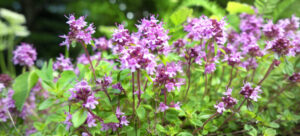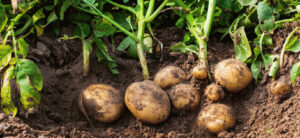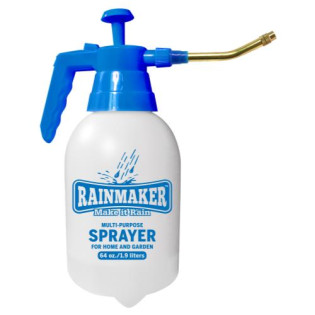
There is no shortage of reasons to learn how to grow a potato plant. There’s nothing quite like a big, savory potato to liven up the dinner table.
If you’ve ever thought about growing potato plants, but decided it might be too hard, then don’t worry - you’ve come to the right place.
We are going to teach you everything you need to understand how to grow a a potato plant, whether you start from seeds, cuttings, or an actual potato itself!
We'll help you choose the right varieties, and create the best conditions for your garden. Then, we'll teach you how to actually harvest your potatoes, and get them to the table for you and your family to enjoy!
We've got a lot to cover, so without further ado, let's get started.
What Are The Best Potato Plant Varieties To Grow?
Before you learn how to grow a potato plant, you need to consider which variety you are going to cultivate.
There are several kinds of potato plants you might want to consider growing as a beginner gardener. Some of the most popular include:
- Yukon Gold
- Red Pontiac
- Purple Majesty
- Princess Laratte
- Swedish Peanut Fingerling
- Masquerade
- Red Gold
- Kennebec
- Daisy Gold
- Rio Grande
The best kind of potato for you to grow will depend on your unique preferences in terms of diet. Do you eat a lot of mashed potatoes? You’ll want to grow lots of Yukon Golds, as these are perfect for this type of recipe.
Prefer a hearty roasted potato dish? Red Pontiac will be the ticket. Consider planting several of each kind for a bountiful and varied harvest.
When To Plant Potatoes For Best Results

Now that you know what variety you are going to plant, you need to ask when to plant potatoes?
The answer varies depending on where you live, as well as if you start with seed potatoes, cuttings, or actual seeds.
Ideally, seed potatoes should be planted about two to three weeks before the last average frost date. If planted too early, seed potatoes can rot in waterlogged soil.
Usually, if your potatoes succumb to a heavy frost after they’ve just emerged, they should still be able to put up new shoots.
However, each “death” of a shoot can cause the plants to produce a smaller, delayed harvest, so try to avoid a hard freeze if possible.
Play It Safe, Plant Potatoes Later!
The answer to the question "when to plant potatoes" might vary depending on your specific climate. In most cases, waiting for the soil to be warmer is ideal. For many gardeners, that will be sometime between late March to early May, although in the south, they can be planted in late fall or early winter.
You may also choose to grow your potatoes from seeds indoors, but this is much less common.
Most gardeners will simply sprout their potatoes from eyes cut from other potatoes. To do this, you will want to start seeds indoors about six weeks before the date of the last frost.
If you're going to start this way, you might be wondering, how deep to plant potatoes from seed indoors. It's actually pretty straightforward. Sow your seed about a quarter of an inch deep in plug trays and transplant into the garden as you would following the instructions for seed potatoes below. Now that you know when to plant potatoes, let's move on to how to plant potatoes.
How To Plant Potatoes - Step By Step
Now, let's get into the meat and potatoes (pun intended) of what you came here to learn about - how to grow a potato plant.
Our step-by-step guide will have you cultivating delicious, nutritious food in no time. Let's start with the most important part - how to plant potatoes.
How To Plant Potatoes - Tips & Tricks
To teach you how to plant potatoes, we're going to start by explaining your options when it comes to propagation. Then, we'll explain how deep to plant potatoes.
If you’re growing a potato plant from seed potatoes, you might want to cut larger-sized potatoes into multiple pieces. By doing this, you’ll be able to spread your seed much further for a larger yield. If worms are a problem in your garden, though, you may want to plant the potatoes whole.
Leave two eyes per piece, using a clean knife to cut the potato into multiple pieces. Let the pieces sit in a cool, humid space overnight so that they call us up before you plant them.
This will prevent infection and rot that can occur when you put your potatoes in the ground. When you’re ready to plant, then comes the most important question you'll have when learning how to plant potatoes - how deep to plant potatoes?
Dig a shallow trench that’s up to eight inches deep. Place the cut potatoes about a foot apart in the trench. Space the rows about three feet apart, then backfill with soil, leaving the trench only partially filled. Easy as that!
Soil Conditions For Potatoes
Potatoes should be grown in loose, fertile soil. Before planting, do your best to loosen the soil and add organic matter or compost.
Ideally, you should add this matter in the fall so that it has plenty of time to work into the soil. Fresh manure or too much nitrogen can cause the potatoes to develop scabs.
Too much nitrogen can also cause your plants to delay their root production, meaning you’ll have lots of leafy green potato tops - but tiny potatoes underneath.
If you're looking for a specific recommendation for growing potatoes, check out our year-end review of the best soil for plants!
Sunlight and Water For Potatoes
Potatoes need about one inch of water per week. Try to stick as closely to this recommendation as possible - too little water can lead to potatoes that are small and hard, while too much can cause fungal issues. This is why it's important you learn how to properly water plants.
Other than that, all your potatoes need is plenty of sunlight. Choose a location that receives full sunlight for best results.
If you are growing in a greenhouse, supplemental grow lighting may be necessary to give your potatoes the light energy they need to reach their full potential.
Caring For Your Potato Plants
Caring for your potatoes isn't going to require a ton of work, but there are some routine tasks you'll want to do to ensure a successful harvest down the line.
Some of these tasks include hilling, monitoring for pest/disease issues, etc.
Hilling Your Potato Garden

One of the most confusing parts of growing potato plants, at least for novice growers, is the idea of hilling.
Hilling involves mounding soil around your plants when they're about eight inches high. You’ll cover the plants with soil around the vines from both sides.
You’ll need to hill several times during the growing season, covering the vines so that only the top potato plant leaves are exposed.
Hilling can be done with soil or it can be done with a mulch. Mulch is beneficial in that it will help the soil retain moisture while also allowing the plants to breathe.
It can also protect the plants from potato beetles. If you don’t want to worry about hilling, just plant your potatoes a bit deeper (about nine inches).
Your potatoes will be smaller and you’ll likely have lower yields, but you won’t have to hill. Potatoes prefer soil that is slightly acidic. You can add some fertilizer before planting to get the potatoes to where they need to be.
Mulching your potatoes will help them retain moisture without falling victim to fungal diseases but otherwise, no other care is necessary.
Additional Garden Potato Care (Pests & Diseases)

There is no potato plant leaves pruning or training required. As long as you follow the steps mentioned above when planting and caring for your potato plants, you shouldn’t have any issues with pests or diseases.
However, there is one exception to this, and it’s a disease that can afflict even the most experienced potato gardener - potato blight.
Potato blight is a fungal disease that can easily destroy an entire crop. Reduce your chances of infection by rotating your crops so that your potatoes are never grown in the same spot for two years in a row. It displays itself on your potato plant leaves.
Avoid planting them where other crops in the nightshade family, like peppers, tomatoes, or eggplants, were grown, too. The disease can overwinter in the soil.
Potato Companion Plants
There are some potato companion plants you should consider growing around your garden to help you grow better crops. These are "helpful" plants that will allow your spuds to thrive while deterring many of the common garden pests. Our top picks for potato companion plants are:
- Cabbage
- Corn
- Beans
- Horseradish
- Spinach
- Lettuce
- Chamomile
- Basil
- Yarrow
- Parsely
- Thyme
- Petunias
- Alyssium
Not only will these potato companion plants help you deter pests, but these flowers, herbs, and veggies will also enhance the taste and size of your spuds, too!
How To Harvest Your Potato Plants - Watch For Potato Plant Flower

You’ll know your potato plants are getting close to a harvest when they start to see your potato plant flower. Several weeks after you initially notice your potato plant flower, you can dig into the soil around the sides of the vines - here, you’ll find some thin-skinned potatoes, but they'll be small.
If you want to harvest new potatoes, now is the time to do so. However, for potatoes that can hold up to long-term storage, you'll want to wait.
Once the vines start to die back and lose their color - which can happen with a frost or simply when the potatoes are mature - they can be harvested.
Some experienced gardeners will cut or mow down the vines a few weeks before harvest, as this will toughen up the skins and make them last a long time in storage.
When it’s time to harvest, reach into the soil with your hand and pull up the tubers. Be careful while digging potatoes so that you don’t damage the skins.
Let them sit for a few hours to dry, which will toughen the potato skins and prepare them for storage.

Brush the soil off the potatoes but don’t wash them until you’re ready to use them. You can also leave the potatoes in the ground through a few touches of frost. However, if a heavy frost threatens, harvest the potatoes so that those lying close to the surface aren’t damaged.
Can You Grow Hydroponic Potatoes?
When we talked about how to plant potatoes, we were speaking from a soil perspective. Most people plant potatoes in their garden outdoors - but what about hydroponic potatoes? Growing spuds without soil could be a fun challenge worth trying!
Keep in mind that hydroponic potatoes are going to require more care and attention to bring to harvest. There is a lot more room for error, so you'll have to dedicate yourself to learning this gardening technique before you learn how to plant potatoes in a hydroponic system.
But, yes - you can grow hydroponic potatoes with the right supplies, attitude, and patience! Here is how you can get started planting potatoes in buckets.
Start By Choosing A System For Your Hydroponic Potatoes
First, you'll need to find a system for your hydroponic potatoes. We like planting potatoes in buckets style systems, like these automatic watering systems. Planting potatoes in buckets allows them plenty of room to grow deep and down into the bucket - so you get a good yield.
When it comes to deciding how deep to plant potatoes in your hydroponic system, you'll need to keep them a bit more shallow since you're tight on space in the bucket. We recommend going about 2" deep in perlite - a quality soilless medium.
From there, you'll set up your reservoir with your water and fertilizer, and let the automatic watering system feed your hydroponic potatoes automatically.
Grow Your Hydroponic Potatoes and Watch For Issues As You Normally Would
Once you've gone about planting potatoes in buckets, you're ready to let them grow! Kick back and let your system do its thing. You'll be able to avoid most pests and diseases by growing in a hydroponic system, which is far cleaner and typically grown indoors.
Just watch for your potato plant flower signs, and you'll know it is time to harvest them!
Final Thoughts On How To Grow A Potato Plant
Now you know how to grow a potato plant, and you can try to cultivate some delicious, homemade spuds for you and your family.
Ready to start growing your own potato plants? All that's left to do is take action, plan out your garden, and grab some potato seeds or cuttings!
Once you get the hang of it, you’ll be able to grow enough tasty spuds for your favorite mashes, roasts, soups, stews, and more. Get digging!




















